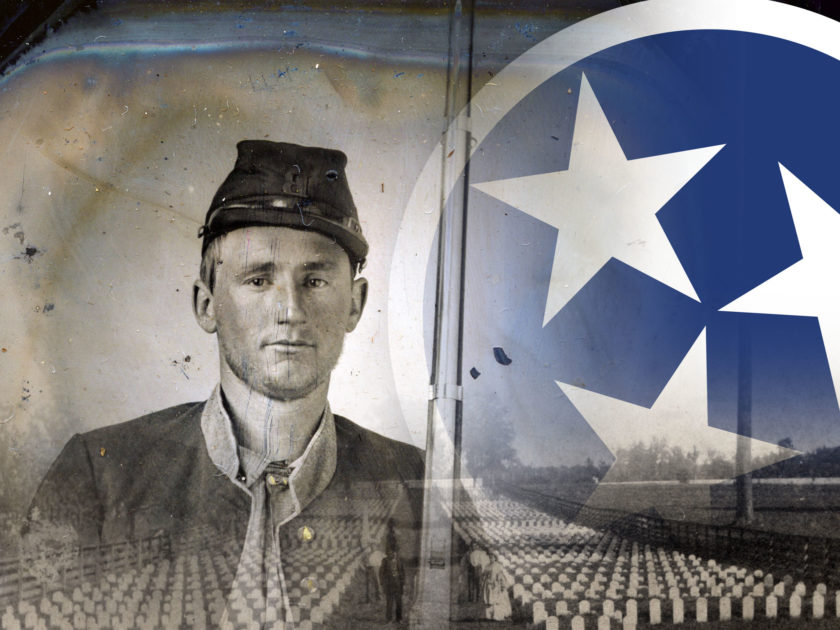One of the earliest, if not the first, references to Tennessee as the “Keystone of the Southern Arch” dates to 1848. An editorial published that year in The Tennessean used the phrase to describe its unique location, “surrounded on all sides by wealthy States which must for their own interest, desire a passage across her territory.” The editors went on to point out that tensions between the eastern, western and middle sections of the state caused infrastructure improvements to lag behind its neighbors. When the sections put the interests of all Tennessee first, “she must before many years hold a most enviable position in the rank of States.”
Flash forward to 1860, and the secession crisis. Sectional divisions still lingered in Tennessee. The west favored separation from the Union, while the east preferred to remain. At first, the middle sat almost evenly divided, but soon after moved in favor of secession. On June 8, 1861, Tennesseans voted to join the Confederacy, becoming its 11th and final state.
The 1848 editorial bespoke commerce and wealth. The year 1861 brought the business of war, and, with it, death and destruction on an enormous scale that few dared to imagine. Confederate soldiers marched along its roads and moved along its railways and rivers to defend the state against invading federal forces, which used the same byways to suppress the rebellion. Inside its borders, blue and gray fought about 2,900 engagements—second only to Virginia. Included were some of costliest battles in terms of human life: Stones River, Shiloh and Franklin.
Eight months after Tennessee joined the Confederacy, it became the first state to lose its capital after Union victories at Fort Henry and Fort Donelson rendered Nashville untenable. When Confederate forces evacuated the city, the loss of the keystone compromised the Southern arch.
Altogether, 173,681 sons of Tennessee joined the military. More than three-quarters, 135,812, served the Confederate cause, while the remainder, 31,092 whites and 6,777 blacks, served the Union.
The following are representative portraits and accounts of Tennesseans in gray. Some of the images appear in MI for the first time, while other previously published photographs featured here include additional information about the soldier’s lives and war experience.
Missed Reunion

On Sept. 23, 1887, veterans of the 1st Tennessee Infantry gathered in Franklin for a reunion. Absent was William Patton Rutland, who had died the day before at age 47 after a brief illness. A prosperous merchant, his comrades praised him as a brave and faithful soldier.
Will Rutland began his service in May 1861 in his hometown of Nashville as a private in the Rock City Guards, which became Company B of the 1st. The company letter is visible on his cap in this image. He wears a dark shell jacket with a small stripe running down the middle. He is armed with a Model 1861 Springfield rifle.
After the Battle of Perryville, Ky., he remained behind to tend to the wounded—perhaps evidence of one writer’s description of him as “one of the purest and most dauntless spirits.” Rutland’s military record indicates he returned to Tennessee and remained on detached duty as a nurse into May 1863. Before the war ended, he returned to a combat role with the 4th Tennessee Cavalry, and signed the oath of allegiance to the U.S. government in June 1865.
Rutland’s post-war prosperity ended in untimely death. His wife and two sons survived him.
Tennessee vs. Tennessee

Gen. Nathan Bedford Forrest ordered one of his brigades to make a demonstration in front of Union-occupied Memphis in late March 1864. His chief aim was to mislead the federals into believing he planned a larger attack on the city. It worked. Forrest received an added bonus when, on March 29, one of the regiments in the brigade, the 14th Tennessee Cavalry, attacked the Union 6th Tennessee Cavalry at Bolivar, outside of Memphis. The troopers captured much-needed ammunition and supplies.
The man who led the assault, Col. James Jackson Neely, is pictured here. He knew Bolivar well, for he had practiced medicine there before the war. In 1861, he became a captain in the 6th Tennessee Cavalry Battalion. In mid-1863, he raised a new cavalry regiment, the 14th, within federal-occupied western Tennessee. He took command as colonel. Neely was not the only colonel in the family. His eldest brother, Rufus, led an infantry regiment.
About six months after Neely and his men routed the Unionist Tennesseans at Bolivar, a junior colonel was placed in command of the brigade. Neely and other senior officers protested. Forrest punished them all with censures and suspensions—and cashiered Neely. His dismissal ended the military career of a talented officer.
Neely returned to Bolivar and his profession as a doctor. He also served as a county sheriff. He died in 1894.
A Tale of Two Rivers

The 500-strong 33rd Tennessee Infantry shared in the glory of the first day’s fight at Shiloh at a cost of almost 40 percent of its force. One of the men on the casualty list, Sam Asbury, served as a corporal in Company G. Born Samuel C. Asbury in Kentucky, he lived in Obion County, located in Tennessee’s northwestern corner near the Mississippi River, at the start of the war. A fisherman by trade, he enlisted in October 1861.
Six months later at Shiloh, Asbury and his comrades attacked the enemy camps along another river, the Tennessee. Exactly where and how he suffered his wound is unknown. But it proved mortal. He died on May 2 at a Confederate hospital in Grenada, Miss. He was about 25.
A Memphis Light Dragoon

When the Memphis Light Dragoons formed in 1861, its ranks included John Thomas “Tom” Garrison. An Alabamian who had moved with his family to Oakland, a community outside Memphis, he is pictured here wearing a high-crowned cap and federal style coat adopted by some early war companies, notes MI Senior Editor Ron Field. The Dragoons became Company A of the 7th Tennessee Cavalry, which engaged in operations in Kentucky, Mississippi and Tennessee.
Garrison left the 7th before February 1864 to help organize a cavalry company in the Oakland area. The recruits elected him first lieutenant. The men became Company B of the 15th Cavalry, which served in Gen. Nathan Bedford Forrest’s command in western Tennessee.
Garrison survived the war, returned to his Oakland farm, and lived until 1912. He left behind a wife and 11 children. His obituary noted, “No man who enlisted in the army from this section was more feared by the Yankees than he, and the death of none was more desired than was his.”
Pay Day

On Aug. 16, 1864, Pvt. James A. Mason drew his pay in Confederate dollars at Tupelo, Miss. The 17-year-old Arkansas native, who appears to have been orphaned at an early age and left with family or friends in Madison County, Tenn., wrote his name and particulars of his service on the back of a five-dollar banknote he received that day: “Company K, 19th Tennessee Cavalry, Col. Tyree Harris Bell’s Brigade, Brig. Gen. Abraham Buford’s Division, Maj. Gen. Nathan Bedford Forrest’s Cavalry.”
 During the months leading up to Mason’s payday, Forrest’s cavalry participated in the battles of Paducah, Ky., Fort Pillow, Tenn., and Brice’s Crossroads and Tupelo in Mississippi. Mason’s role in these engagements is unclear. He did survive the war, however—a veteran at 18. Mason married in 1871, started a family that grew to include five children, and labored as a farmer and preacher in Henderson County.
During the months leading up to Mason’s payday, Forrest’s cavalry participated in the battles of Paducah, Ky., Fort Pillow, Tenn., and Brice’s Crossroads and Tupelo in Mississippi. Mason’s role in these engagements is unclear. He did survive the war, however—a veteran at 18. Mason married in 1871, started a family that grew to include five children, and labored as a farmer and preacher in Henderson County.
In 1901, Mason gifted the Confederate fiver to his daughter, Lida May. Mason died of heart problems in 1917 at a hospital in St. Louis, where his only son lived. Mason was 69. A century later, his image and other relics turned up in a St. Louis antiques mall.
Mule Steak

According to a comrade, 4th Sgt. Hiram Washington Keller of Company M enjoyed a healthy appetite and appreciated the finer things in life. Not surprisingly, he suffered when meat became scarce. He made up for it one day when an artillery shell killed a mule. Keller and another man “cut a bucket full of steak from said mule and we all soon joined in with them in a nice repast.”
Exactly when and where this event occurred went unrecorded. One possibility is the Siege of Vicksburg. Keller numbered among those surrendered when the city fell to Union forces on July 4, 1863. Paroled the next day, his service record indicates he was absent without leave for the rest of the war. Keller later became a farmer in Henning, Tenn., and died of a cerebral hemorrhage at age 92 in 1928. His wife predeceased him, and five children survived him. His obituary noted that he was a good citizen, soldier and Christian. “When the boys in Grey fell in to protect their beloved homeland, he was one of the very first to shoulder arms.”
Wounded at Murfreesboro

Pvt. Charles Wesley Sadler and 597 of his comrades in the 17th Tennessee Infantry advanced into the Battle of Stones River at sunrise on Dec. 31, 1862. They spent the next nine hours in combat alongside their brother regiments in Gen. Patrick Cleburne’s division. “It was a bloody march,” according to the Military Annals of Tennessee, “assailing line after line of the enemy without relief or support. During the time the regiment captured three batteries.” The 17th paid a high price for success—246 casualties, or 41 percent of its fighting force.
Sadler numbered among the injured, having suffered a minor wound in the leg. A native of Putnam County who lived in neighboring Jackson County at the start of the war, he joined the 17th in June 1861.
His military service record ends with his wound at Stones River. Sadler’s whereabouts during the rest of the war are not known. His comrades soldiered on through Appomattox, Va., where 68 officers and men surrendered.
Sadler married in 1866 and eventually returned to Putnam County, where he died in 1913 at about age 75.
The Shells of Resaca

During the Battle of Resaca in May 1864, the men of the 20th Tennessee Infantry crowded in earthworks for protection from enemy artillery. Their number included 1st Lt. James William Rawley. The men packed together so tightly that the head of one soldier, Pvt. John Savage, lay against Rawley’s hip. As shells burst, one exploded with deadly effect. According to the regimental history, the shot “took John Savage’s head off and drove his old white hat into a black gum log, and tore about three pounds of flesh from Lieut. Rawley’s hip.”
Three years earlier in Nashville, Rawley had started his military service in the Sewanee Rifles, which became Company C of the 20th. He was one of four brothers that joined the Confederate army. The enlisted man seated next to him in this portrait may be one of them—Darius, Lafayette or Pleasant.
Rawley survived his Resaca wound and the war. He returned to Nashville and died at age 66 in 1900. He outlived his wife, Mary, by 10 days. Three children survived him.
1864

The year 1864 proved challenging for William W. Hawkins, a corporal in the 2nd Tennessee Cavalry, part of Gen. Nathan Bedford Forrest’s command. In February, he suffered a slight wound during Forrest’s Expedition to Meridian, Miss. His second wound, a severe injury to his hip, occurred on April 12, 1864, during the Battle of Fort Pillow, also known as the Fort Pillow massacre in light of reported killings of black and white Union soldiers after the federals surrendered. Hawkins “never recovered from the effects of the wound,” noted one writer, who added that he was “brave to a fault, true to every honorable instinct of humanity.”
Hawkins returned home and resumed his occupation as a blacksmith, though he did so with much difficulty due to his condition. In early March 1868, his home caught fire. In an attempt to extinguish the blaze he re-opened his wound. Two weeks later he died at age 29. A Mason and a Methodist, his loss was mourned by neighbors and churchmen.
The Torpedo Expedition

“The rebels on the line of the Nashville and Chattanooga railroad have introduced a new weapon for the destruction of railroad trains,” reported the Nashville Union from the federal-occupied city on June 27, 1863. The story described how mines, or torpedoes in period vernacular, placed beneath tracks had damaged two trains.
The officer in charge of the mission, Nashville native Henry Clay Brooks, was one of four brothers who joined the Confederate army. All were encouraged to fight by their mother, Ann. She labored in Nashville-area hospitals, bringing family slaves with her to care for sick and wounded men. Following occupation of the city by Union forces, she ingratiated herself with federals and passed intelligence to the Confederates.
Brooks began his war experience in May 1861 as a private in the 11th Tennessee Infantry. He soon joined the officers’ ranks, and served brief stints on the staff of Brig. Gen. Henry A. Wise and as a drill instructor to the 44th Tennessee Infantry.
Brooks’ highest profile service occurred on or about June 26, 1863, southeast of Nashville near Lavergne. According to newspaper reports, Brooks and a detachment of men exploded torpedoes at two places along the railroad. Union troops spotted Brooks and chased him and his soldiers to the Cumberland River. There, Brooks and party crossed the waterway and eluded their pursuers.
Union-controlled media reported minor damage to two locomotives. But according to a Southern correspondent for the Chattanooga Rebel, Brooks had inflicted considerable damage.
“One of the torpedoes destroyed the engine and seven cars, killing and wounding a large number of soldiers, while the other torpedo destroyed the engine, killing the engineer and entirely destroying five other cars, tearing up the track for a distance of about sixty yards.” News of the Confederate losses at Gettysburg and Vicksburg overshadowed the event.
Brooks survived the war and died in 1878 at about age 35.
Murdered

The person who scratched the fates of these two men into the emulsion of their photos was a loyal Confederate. Use of the term “murder” to describe how they died, and attributing the act to a Union officer, tells us as much.
The story of how these three men crossed paths can be found in an after-action report detailing a scouting mission southwest of Nashville in Hickman and Maury counties. On May 7, 1864, 2nd Lt. Jordan Washington Creasey of the Union 12th Tennessee Cavalry, and a detachment of 25 troops, captured two men believed to be guerrillas. Creasey then learned of two more guerrillas and, according to the report, “after striking their trail he pursued them o’er hill and dale until finally he was upon them, they being concealed in a house of ill-fame, situated in a most secluded spot on top of a large bluff. The lieutenant, fearing escape on their part, dashed upon them and shot them, both before any of his party were on the spot.” The dead men had in their possession four pistols and three horses.
The two men 2nd Lt. Creasey killed are pictured here.
Edward Henry Pointer, 22, left, a Williamson County native, attended Cumberland University in Lebanon, Tenn., where he was a brother in Phi Kappa Sigma fraternity. He joined Holman’s Battalion, Partisan Rangers, which became Company B of the 11th Tennessee Cavalry. According to the Military Annals of Tennessee, he was on detached service as a scout and surrendered to Creasey, who murdered him with his own pistol. Pointer’s remains are buried in the family cemetery in Williamson County.
The other victim was named Buford or Beaufort. He appears here in uniform with corporal’s chevrons. He may be L.C. Buford, who served in Company D of the 11th.
About a month after the deaths of Pointer and Buford, Creasey received his captain’s bars “for gallant and meritorious service on several occasions.” He mustered out of the army in July 1865, and returned to his wife, Lavina, whom he married during his service in 1863 in Tennessee. They had two sons, one adopted, and another who died young. They settled in Clark County, Ill., where Creasey died in 1897 at about age 64.
“Second to No Woman in the South”
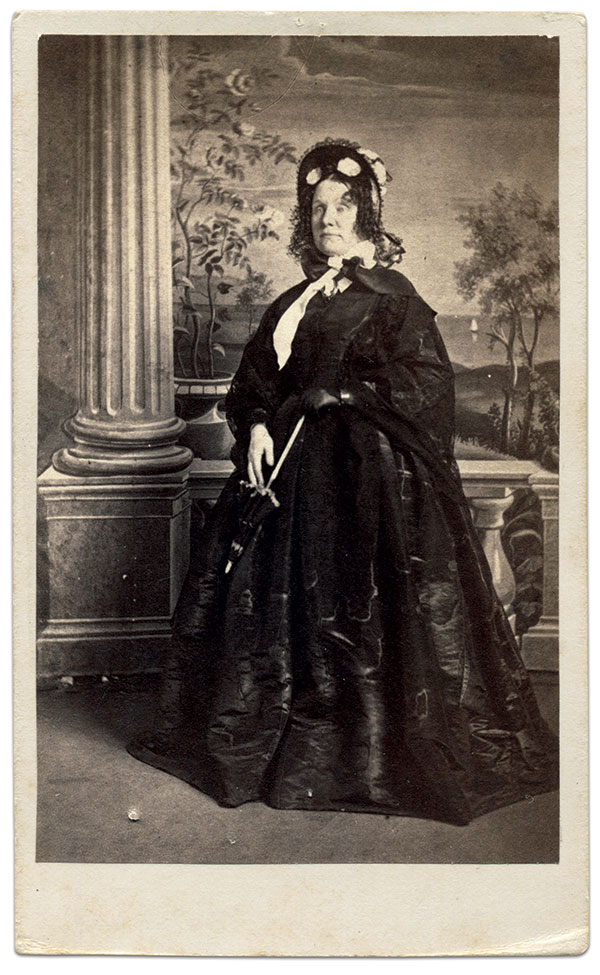
Felicia Ann Grundy enjoyed life as one of Nashville’s elite during the years before the war. Some noted her powerful intellect reminded them of her father, renowned U.S. Senator Felix Grundy.
By the time hostilities erupted, she had buried two husbands. Grundy poured her heart and soul to support the sons of Tennessee and other Southern states, even after Union forces occupied the city. She survived it all, and lived until 1889. She was 69.
More than two decades later, a portrait and sketch of her Confederate services appeared in the landmark 1911 series Photographic History of the Civil War by Francis Trevelyan Miller.
Captured Twice
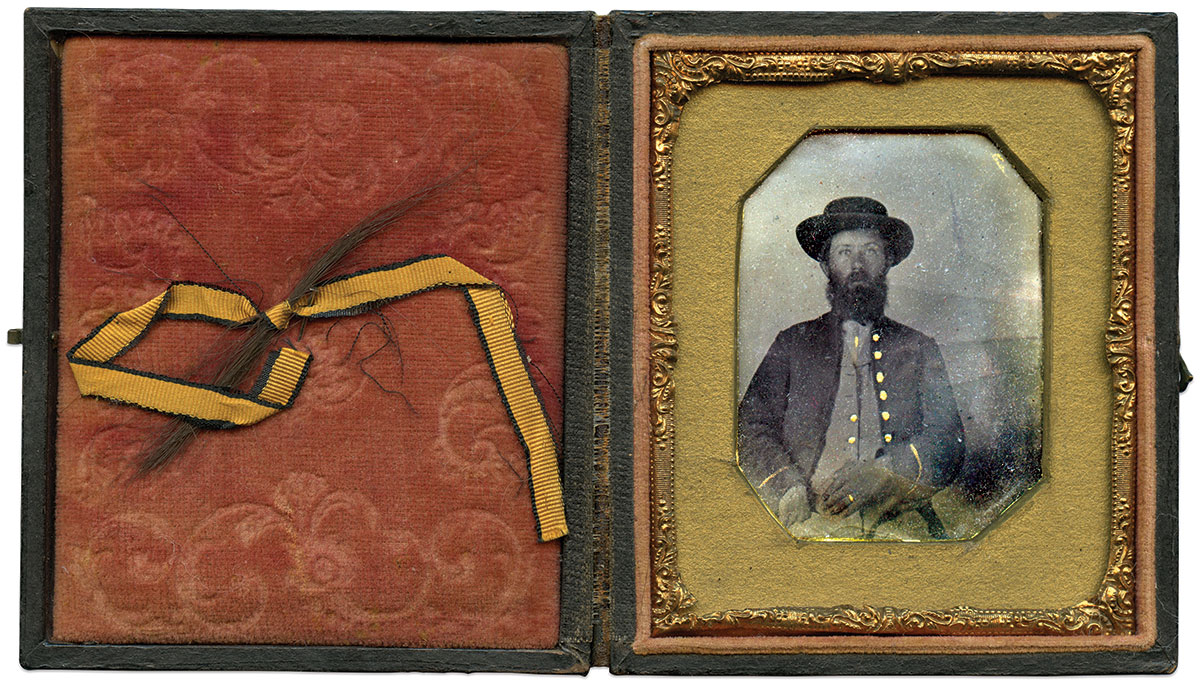
Following the surrender of Vicksburg on July 4, 1863, Union forces moved on the Mississippi capital, Jackson. On the night of July 16, Confederates withdrew from the area. During the retreat, Pvt. Francis M. “Frank” Drake of the 49th Tennessee Infantry’s Company A went missing. He fell into enemy hands and, on Aug. 7, 1863, arrived at Camp Morton in Indianapolis, Ind. This was his second time as a prisoner of war. The first occurred a year earlier at Fort Donelson, when he and his company fell into enemy hands and spent seven months in Chicago’s Camp Douglas.
Drake survived his ordeal and the war. He died about 1880, in his mid-40s.
Distinctive Trooper

In southeastern Tipton County, the sight of a cavalry company of local men resplendent in triple-breasted uniforms trimmed with tassels and plaited ribbons, and topped off with broad-brimmed hats folded on one side, must have stirred the souls of patriotic citizens. They were part of Hill’s Cavalry, named for its captain, Charles H. Hill.
One of the captain’s troopers seen here, Leslie J. O’Kelley, sits with an eagle-headed sword in one hand and a secession cockade pinned to his uniform. The company letters “HC” appear on his hat. Born in neighboring Fayette County, O’Kelley was the only son of three children born into a North Carolina farm family. Eight slaves also lived on the property.
O’Kelley and the rest of Hill’s Cavalry, along with three companies from nearby Shelby County, formed the nucleus of the 7th Tennessee Cavalry. Hill’s Cavalry became Company B.
On May 5, 1862, in Weakley County, Tenn., Company B formed a mounted skirmish line in advance of their regiment and another commanded by Col. Patrick Cleburne. The skirmishers happened upon Union pickets at Lockridge’s Mill, and attacked them. According to the regimental history of the 7th, “O’Kelley rushed to the front, and having discharged his gun and pistol, drew saber, and, overtaking one of the enemy’s troopers, engaged him in personal combat. The fight was short, Private O’Kelley receiving a cut on the head, when the Federal trooper fled. His hurts were not ascertained. Private O’Kelley, however, remained in the combat, and soon afterward captured the enemy’s quartermaster and brought him to head-quarters.”
O’Kelley remained in the ranks through the end of the war, became a corporal, and appears on the rolls of men surrendered at Gainesville, Ala., by Lt. Gen. Richard Taylor on May 4, 1865. O’Kelley returned to Fayette County. He later moved to Lonoke County, Ark., where he died at age 74 in 1911. He outlived two wives, with whom he fathered at least eight children.
Survivor

North Carolina-born John A. Jenkins, below, settled in Weakley County with his family as a boy in the 1840s. When the war came in 1861, he cast his lot with the Confederacy and became a second lieutenant in Capt. H. C. McCutchen’s company of Tennessee cavalry, which became Company H of the state’s 7th Cavalry. Starting out 696 troopers strong in 1862, the regiment mustered 210 effectives by October 1863. Various campaigns and engagements, including the Battles of Franklin and Nashville, further depleted the ranks. By the war’s end, the remnants of the regiment found themselves in Alabama when Lt. Gen. Richard Taylor surrendered the military Department of Alabama, Mississippi and East Louisiana. Jenkins, now a first lieutenant, numbered among those paroled. He made his way home to Weakley County, where he married and worked as a farmer. Jenkins died in 1924 at age 88. He outlived his wife, Addie, and was survived by a daughter.
Union City, Summer 1861

A note inside the case of this ambrotype tells the story of a Confederate soldier. William Franklin Henry enlisted as a private in the Jackson Grays on May 15, 1861. Named for his hometown of Jackson, he and his comrades mustered into Confederate service as Company G of the 6th Tennessee Infantry. Henry advanced to sergeant and survived the war. Afterwards, he returned to Jackson, married in 1868, and lived until 1903. His wife, Mary, and a daughter survived him. Henry sat for this portrait in Union City, where the 6th was stationed from May 23 to Aug. 1, 1861. This image was published in Ross Kelbaugh’s 1991 book, Introduction to Civil War Photography.

MI invited teacher Jason Lynn Pate and his students from Lake Road Elementary School in Union City to research Henry and the 6th. This is what they found: “The 6th Tennessee served near where we live. Mustering in at Jackson, these men fought from the west side to the east side of the Volunteer State that we call home. From our research, we found that Henry served at Columbus, Ky., Shiloh, Corinth, Tullahoma, Shelbyville, Chickamauga and our home city of Union City. Our town is home to multiple small skirmishes that were mostly led by Gen. Nathan Bedford Forest. Using current knowledge of the location of Confederate Fort Brown and the location of our school, Pvt. Henry served just a matter of a few miles, as the crow flies. It is possible that Pvt. Henry may have stood where we are typing and researching him!
“The city of Nashville saw war activity, and it was divided on secession. The western part of the state wanted to become Confederates, while the Eastern side wanted to stay part of the Union. Directly in the middle of the two strong opinions was the city of Nashville. After the Cumberland and Tennessee Rivers fell to the Union Navy, Nashville was unprepared for the Northern attack. In these pictures, you can see how our state capital was used as a medical hospital for wounded soldiers. Also, the Howard School, built for school children, was used to house prisoners of war. Imagine a war in America where Lake Road Elementary or your child’s or grandchild’s school would have to be used to hold soldiers for war!”
Conquer or Die

Capt. Thomas Hugh Walker, below, and his Company I went into action at Shiloh with the rest of the 19th Tennessee Infantry on April 6-7, 1862. The regiment, about 400 strong, distinguished itself by participating in events that ended in the capture of Union Maj. Gen. Benjamin Prentiss and his division.
The regiment paid a heavy price—about a quarter of those engaged—during the two-day engagement. The fate of Walker, known as Tom, was recorded in the diary of a lady friend on April 20. “Dear Tom the loved friend of so many hearts is numbered. He fell on Monday the 7th mortally wounded at the battle of Shiloh while leading on his brave daring band to a charge upon one of the enemies batteries. He lived until Tuesday evening at 4 o’clock.” She also reported that one of Tom’s comrades noted “his face shone on Sabbath and on Monday with unusual brightness and on it was depicted the deep determination of his soul to conquer or die.” Walker was 23. His pregnant wife, Annie, survived him. She gave birth to a boy whom she named Thomas Hugh Walker, Jr. He lived until 1881.
Spy vs. Spy
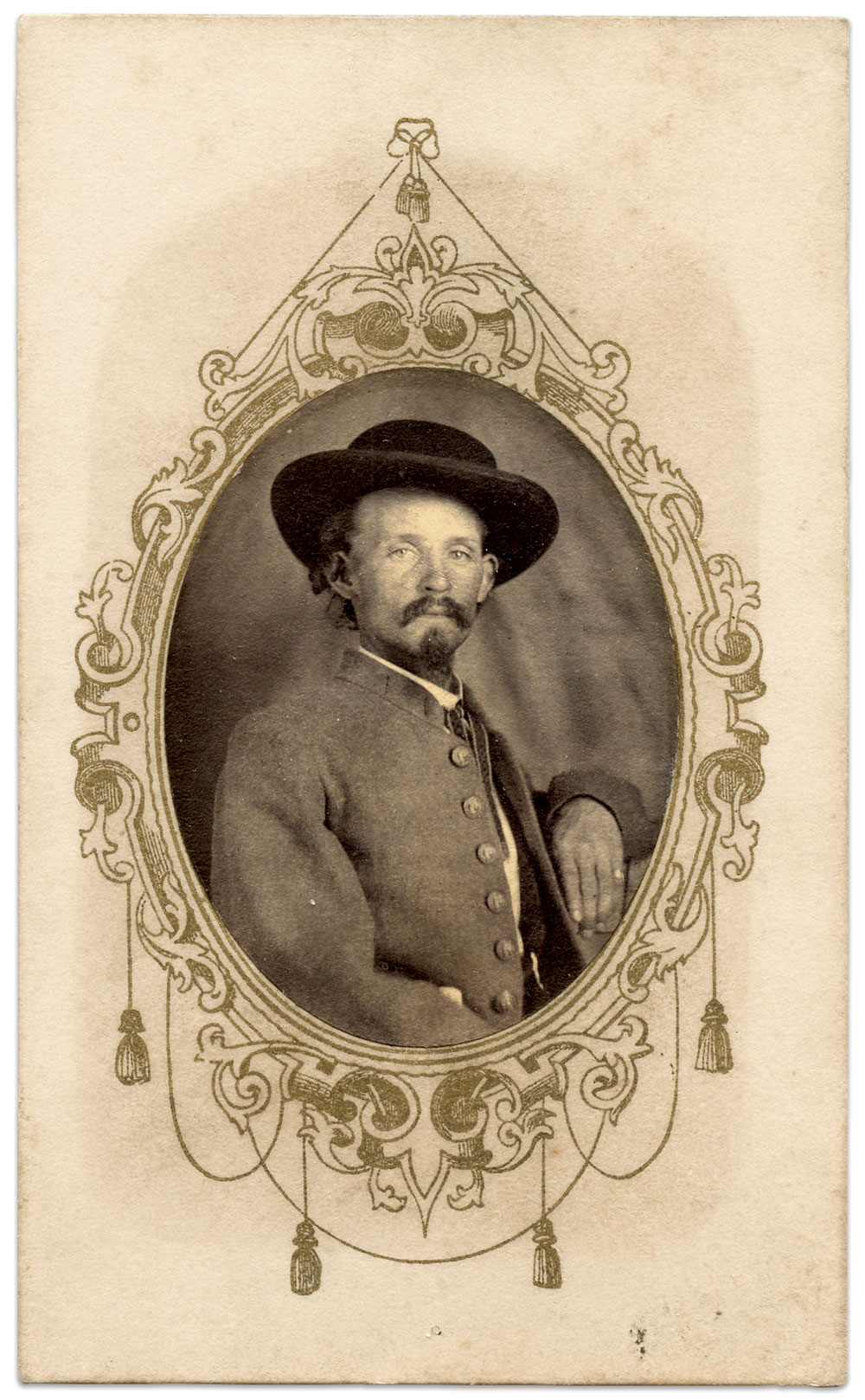
Orders handed down to Lt. George Crosthwaite Ridley, left, required the utmost discretion. He was to lead a 10-man scout to the outskirts of Union-occupied Nashville, from which point he would send a spy into the city to ascertain the strength and location of federal arms. The orders came from the top—Gen. John Hunt Morgan, who commanded the cavalry force that Ridley and his fellow troopers in 9th Tennessee belonged.
Ridley had joined the 9th in the autumn of 1862 from Rutherford County, where he and four other brothers served the Confederacy. So the story goes, Ridley rode off with his troopers and, with the help of a local woman who they recruited to be the spy, gleaned the intelligence requested by Morgan.
Upon their return ride to rejoin their command, Ridley and his men detoured to avoid federal cavalry, and became lost in a place where it was exceedingly difficult to tell friend from foe. About this time, a man, dressed in civilian clothes and on horseback approached the band, and offered to guide them. “We halted him, and at once grew suspicious that his accent was not that of a Southern man, his manner uneasy and his demeanor strained,” stated one of Ridley’s scouts. Upon further examination, they found two uniforms, one gray and another blue, in his saddlebags.
Concluding the man a Union spy, they took him a prisoner and struck out through the night for the journey back to their lines. A few miles into the ride, in a dark and thickly wooded area, the sound of hoof beats and the gentle clank of accouterments was interrupted by a bang. It came from the barrel of a concealed derringer fired by the spy at Ridley. The ball just missed him, leaving a neat round hole in his hat. “Quick as lightning, the Lieutenant, on the qui vive, dropped him, and the scouts riddled him with balls,” recalled an eyewitness.
So much for the spy. Ridley and his boys eventually made it to safety. Ridley went on to become a captain, and later an aide-de-camp and acting assistant inspector general on the staff of Gen. Benjamin J. Hill. He signed a parole on May 16, 1865, in Chattanooga.
Ridley lived a long life, dying in 1931 at age 101.
Long Road Home
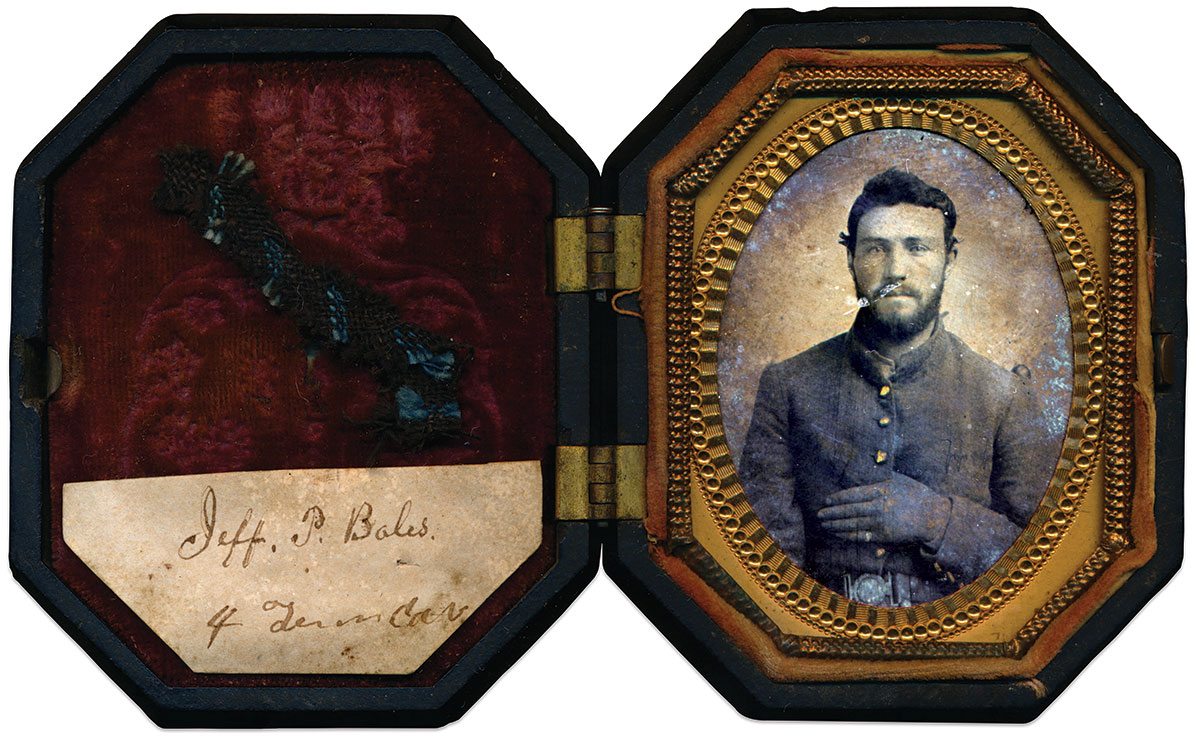
“As a Soldier He Had No Superior”

Wounded Near Carter’s Cotton Gin

Resignation
 On Oct. 28, 1863, Henry Farrar Bowman resigned his captaincy in the 5th Tennessee Infantry. He did so because his Company G mustered only 11 men—six privates, three commissioned officers and two non-commissioned officers. Another 22 enlisted men were absent without leave.
On Oct. 28, 1863, Henry Farrar Bowman resigned his captaincy in the 5th Tennessee Infantry. He did so because his Company G mustered only 11 men—six privates, three commissioned officers and two non-commissioned officers. Another 22 enlisted men were absent without leave.Stonewall’s Counterpart
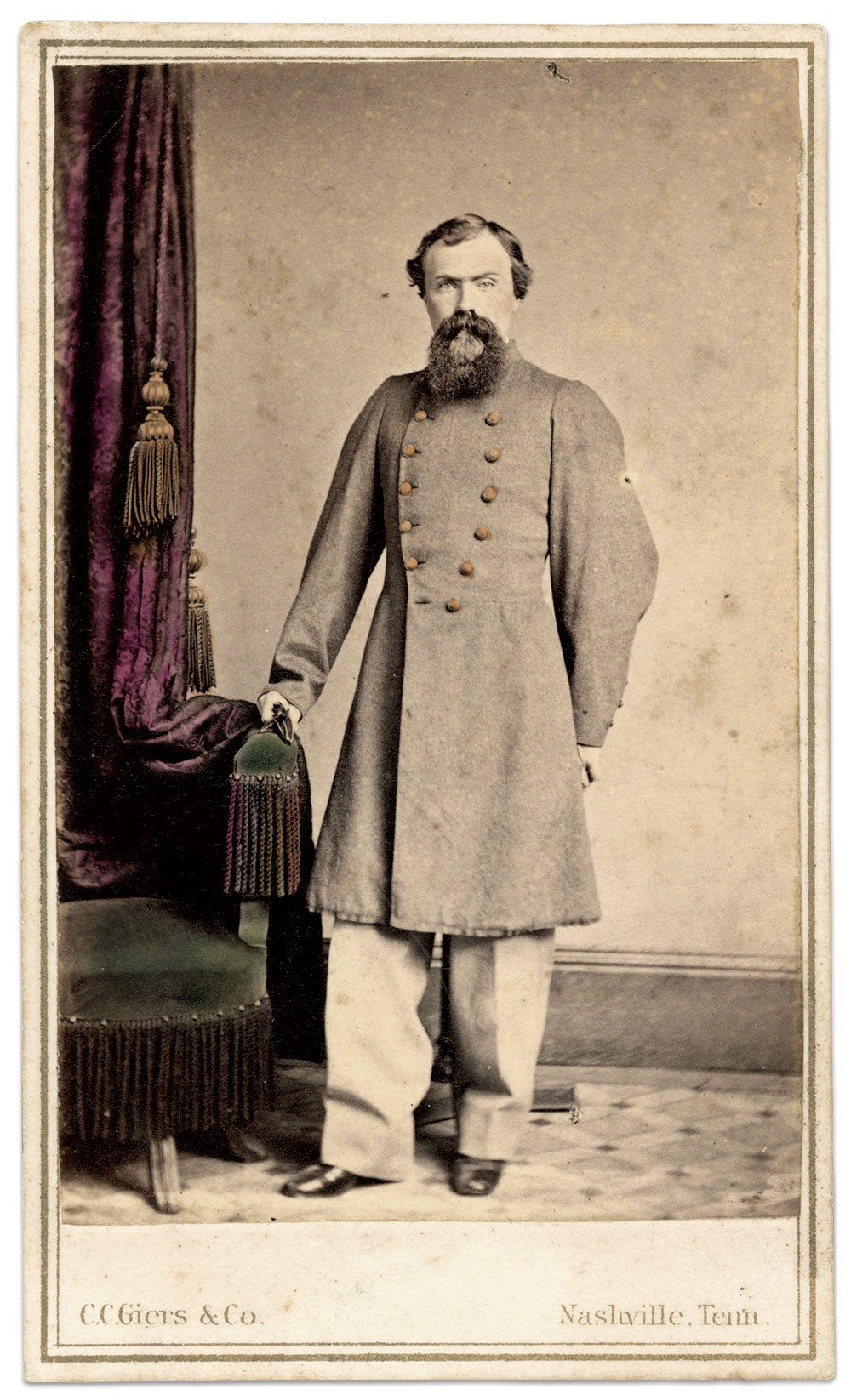
A Gibson Star Falls at Shiloh
 Two notes in the military service record of Capt. Benjamin H. Sandeford reveal his fate at Shiloh on April 6, 1862: “Killed on the battle field” and “Effects in the hands of the enemy and not known.” Sandeford, who commanded a company in the 12th Tennessee Infantry, likely fell during the fighting in the vicinity of Rhea Field, east of Shiloh Church. He was about 32.
Two notes in the military service record of Capt. Benjamin H. Sandeford reveal his fate at Shiloh on April 6, 1862: “Killed on the battle field” and “Effects in the hands of the enemy and not known.” Sandeford, who commanded a company in the 12th Tennessee Infantry, likely fell during the fighting in the vicinity of Rhea Field, east of Shiloh Church. He was about 32.Last Words
 The uphill charge made by Maj. Flavel Clingan Barber and his 3rd Tennessee Infantry against the enemy during the May 14, 1864, Battle of Resaca ended in success. The price was high. Barber fell with a devastating wound. His loss removed a courageous and able leader from the regiment. A Pennsylvania native, he graduated from Dickinson College in 1850 and settled in Pulaski, Tenn., where he attended Giles College and became a school principal.
The uphill charge made by Maj. Flavel Clingan Barber and his 3rd Tennessee Infantry against the enemy during the May 14, 1864, Battle of Resaca ended in success. The price was high. Barber fell with a devastating wound. His loss removed a courageous and able leader from the regiment. A Pennsylvania native, he graduated from Dickinson College in 1850 and settled in Pulaski, Tenn., where he attended Giles College and became a school principal.Final Wishes
 Time was running short for Maj. Phillip Van Horn Weems of the 11th Tennessee Infantry after he suffered a mortal wound in a charge during the Battle of Atlanta on July 22, 1864. That day, his will and accompanying codicils were recorded in a pocket diary, likely dictated by him to a comrade. Its contents reveal important details of his life. To one of his brothers, he left his Hickman County plantation and most of his slaves (30 men, women and children in 1860) except for three, whom he freed. He desired a monument erected over the graves of his parents. He gave his stallion, if he returned from the battlefield, to a lady friend in Alabama. He left the vest he wore when he suffered his first war wound eight months earlier at the Battle of Missionary Ridge, to his brothers. His clothes, boots, sword and other items were distributed to friends and comrades. One of his final requests: “I desire my brothers to have me disinterred and buried in the family cemetery when the war is over.”
Time was running short for Maj. Phillip Van Horn Weems of the 11th Tennessee Infantry after he suffered a mortal wound in a charge during the Battle of Atlanta on July 22, 1864. That day, his will and accompanying codicils were recorded in a pocket diary, likely dictated by him to a comrade. Its contents reveal important details of his life. To one of his brothers, he left his Hickman County plantation and most of his slaves (30 men, women and children in 1860) except for three, whom he freed. He desired a monument erected over the graves of his parents. He gave his stallion, if he returned from the battlefield, to a lady friend in Alabama. He left the vest he wore when he suffered his first war wound eight months earlier at the Battle of Missionary Ridge, to his brothers. His clothes, boots, sword and other items were distributed to friends and comrades. One of his final requests: “I desire my brothers to have me disinterred and buried in the family cemetery when the war is over.”Raider and Teamster

Judge Blackburn’s War

Chickamauga Corn

Two Years With the 35th
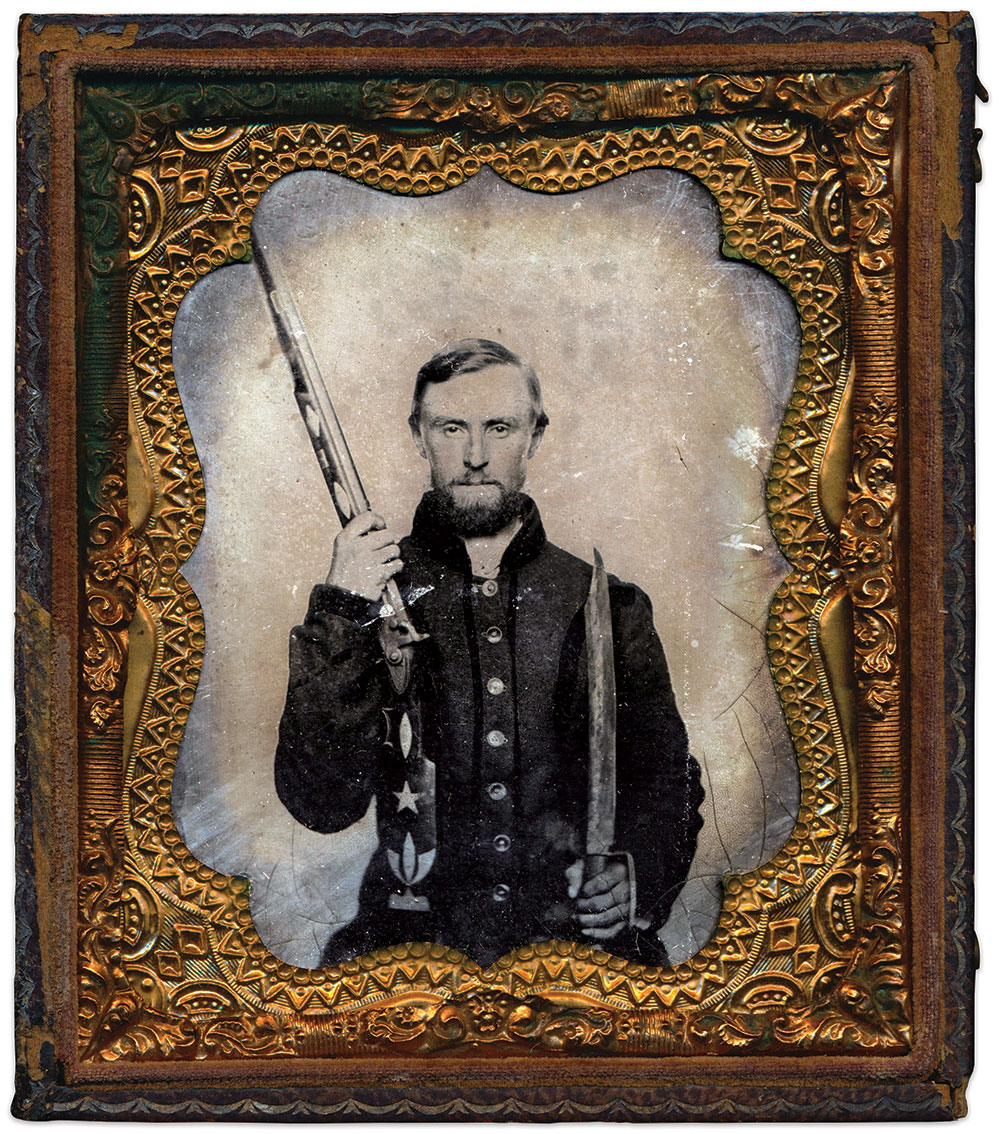
A Memphis Mounted Rebel

“Eager for the Fray”
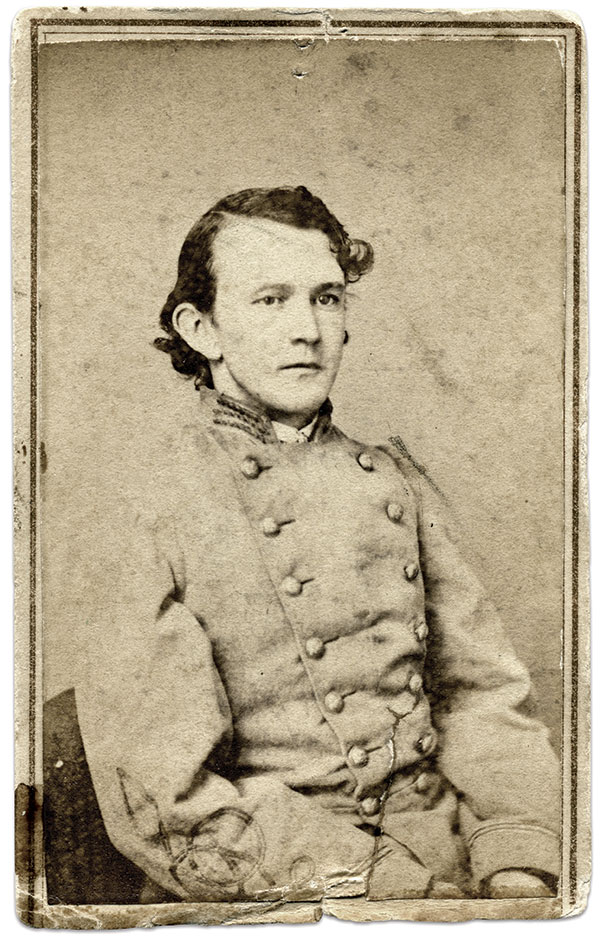
Seed Corn Contingent
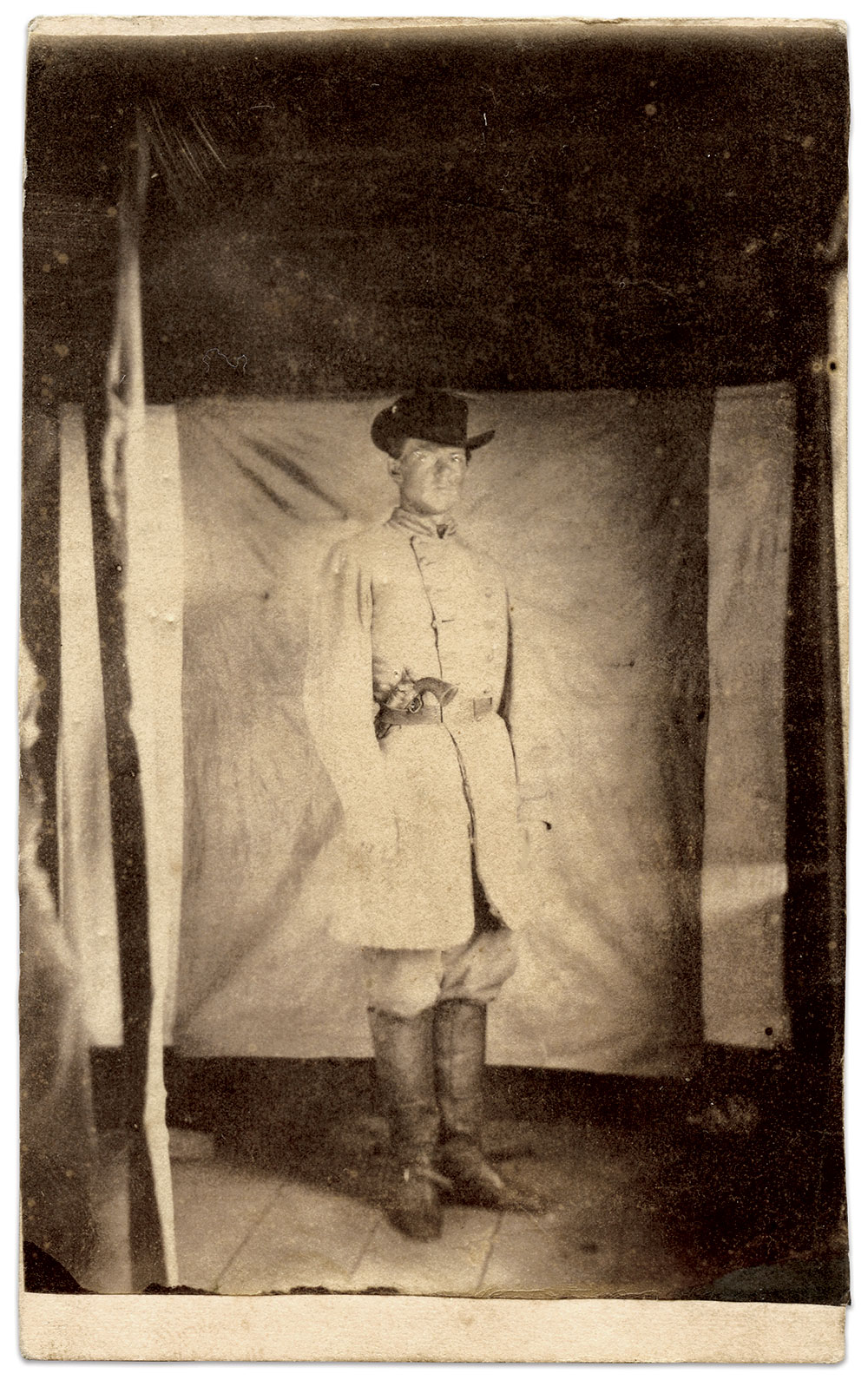
Bill Dawson and His Partisan Rangers
 Gen. Braxton Bragg selected the right man when he authorized William Azariah Dawson to raise a partisan ranger battalion in 1862. A son of South Carolina who had moved to Tennessee, “Bill” Dawson was endorsed by a comrade: “As brave and true hearted a man as ever trod a Battle field. If men wish to be under a leader who will give them an opportunity to do service in the cause, who will bear his share of the hardships of the camp and march, and lead them fearlessly in battle—no better man can be found — We will dare to lead where any man will dare to follow.”
Gen. Braxton Bragg selected the right man when he authorized William Azariah Dawson to raise a partisan ranger battalion in 1862. A son of South Carolina who had moved to Tennessee, “Bill” Dawson was endorsed by a comrade: “As brave and true hearted a man as ever trod a Battle field. If men wish to be under a leader who will give them an opportunity to do service in the cause, who will bear his share of the hardships of the camp and march, and lead them fearlessly in battle—no better man can be found — We will dare to lead where any man will dare to follow.”Pride of Franklin
 On May 18, 1861, in Franklin, Tenn., Capt. James Park Hanner and his Williamson Greys lined up outside the Presbyterian Church, where they received pocket bibles and the pastor’s blessing. Hanner, 25, the principal of Harpeth Academy in Franklin, had raised the company, the core of which was composed of boys from the school. The Nashville native was well qualified for the job. He had graduated from the Western Military Institute in Kentucky in 1853, before going on to receive a medical degree from the University of Pennsylvania.
On May 18, 1861, in Franklin, Tenn., Capt. James Park Hanner and his Williamson Greys lined up outside the Presbyterian Church, where they received pocket bibles and the pastor’s blessing. Hanner, 25, the principal of Harpeth Academy in Franklin, had raised the company, the core of which was composed of boys from the school. The Nashville native was well qualified for the job. He had graduated from the Western Military Institute in Kentucky in 1853, before going on to receive a medical degree from the University of Pennsylvania.All in the Family

The Gloster Boys Go to War


SPREAD THE WORD: We encourage you to share this story on social media and elsewhere to educate and raise awareness. If you wish to use any image on this page for another purpose, please request permission.
LEARN MORE about Military Images, America’s only magazine dedicated to showcasing, interpreting and preserving Civil War portrait photography.
VISIT OUR STORE to subscribe, renew a subscription, and more.

